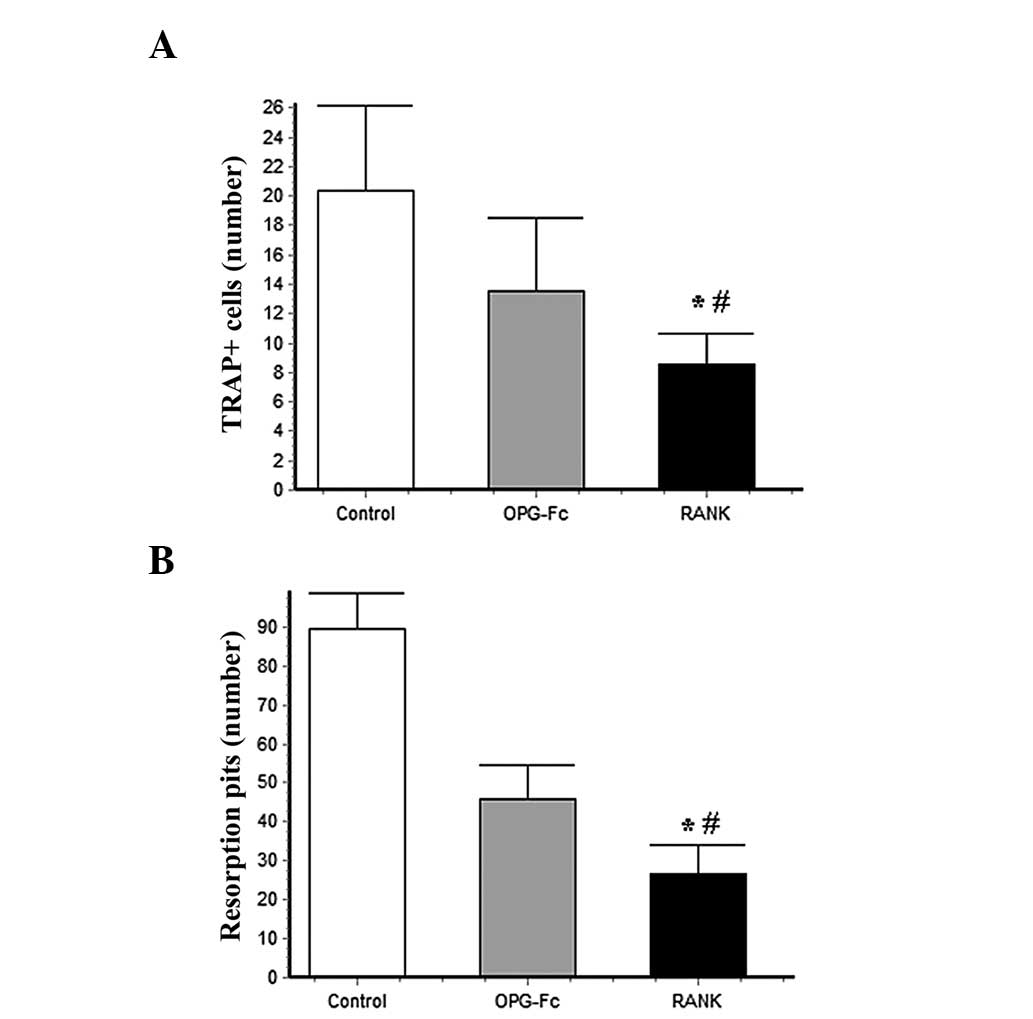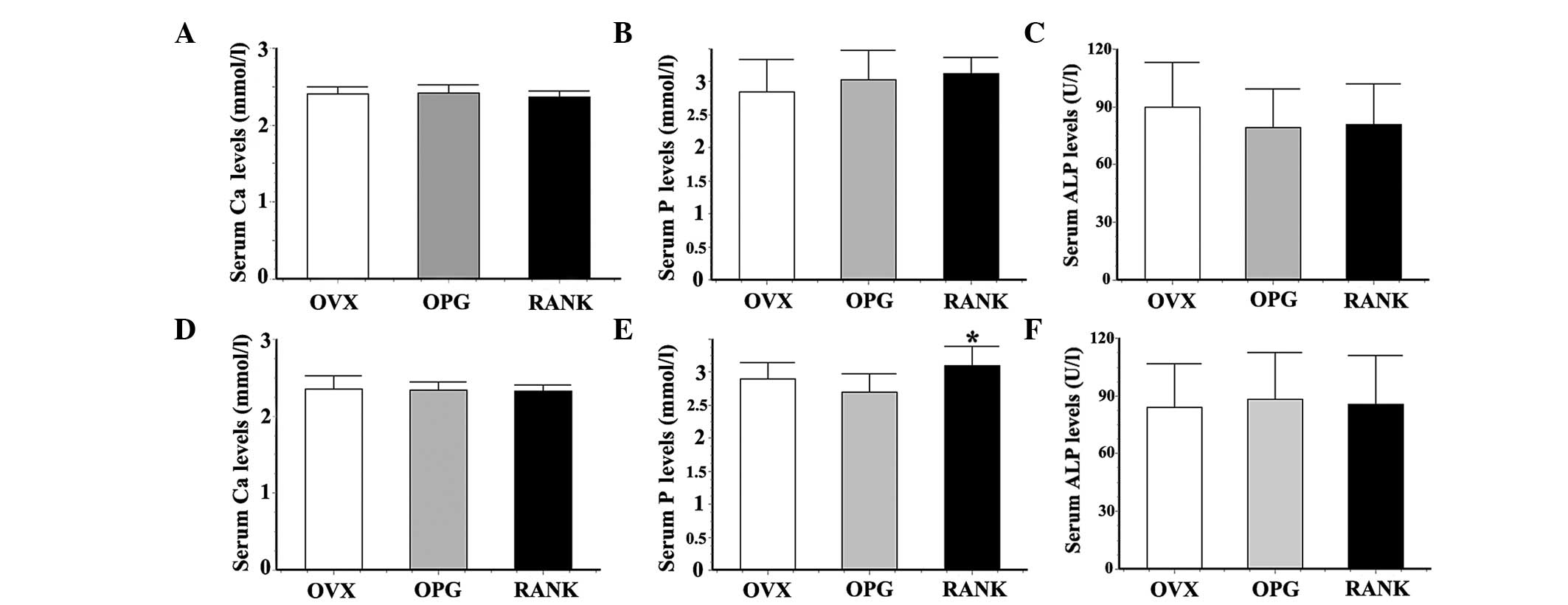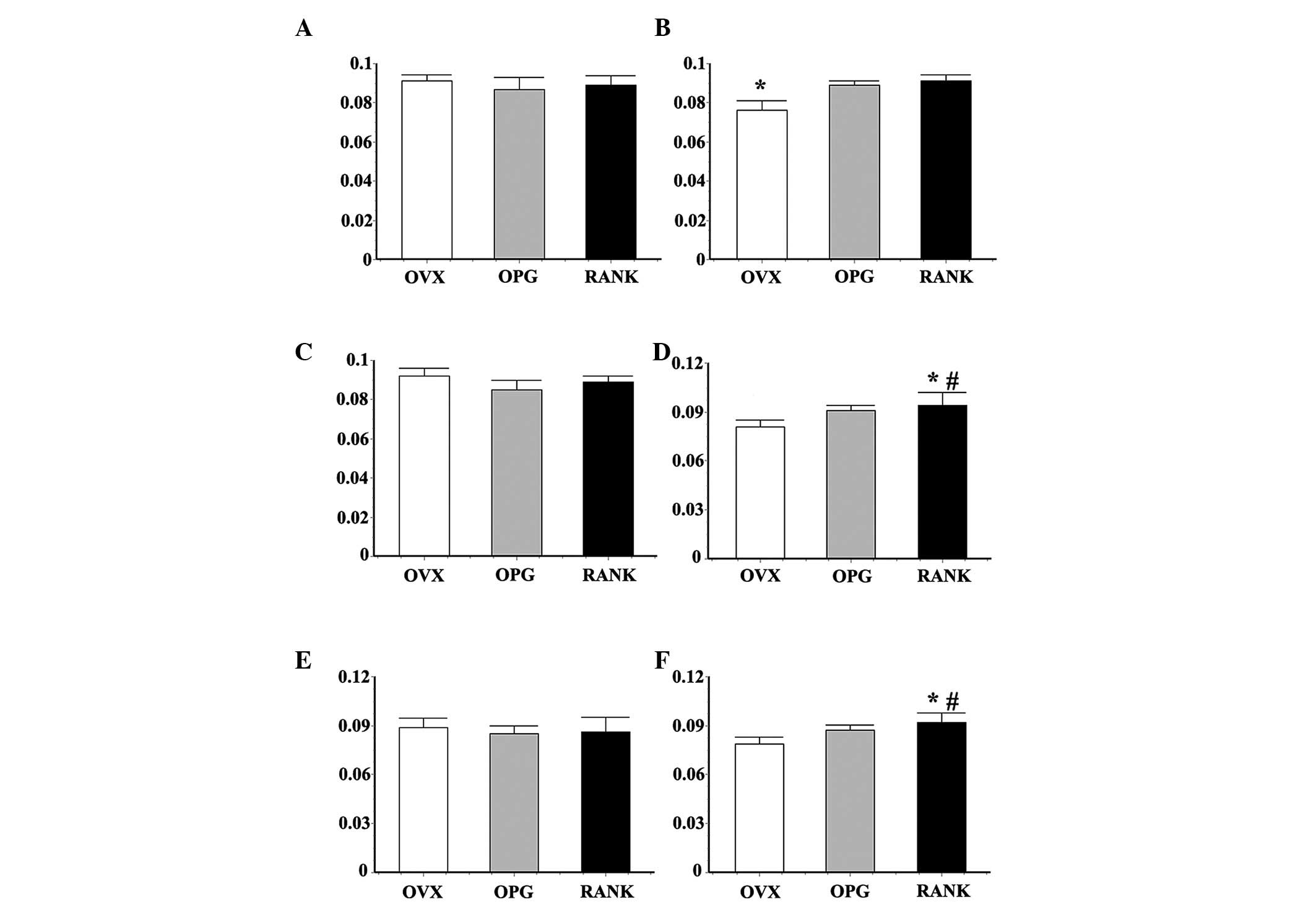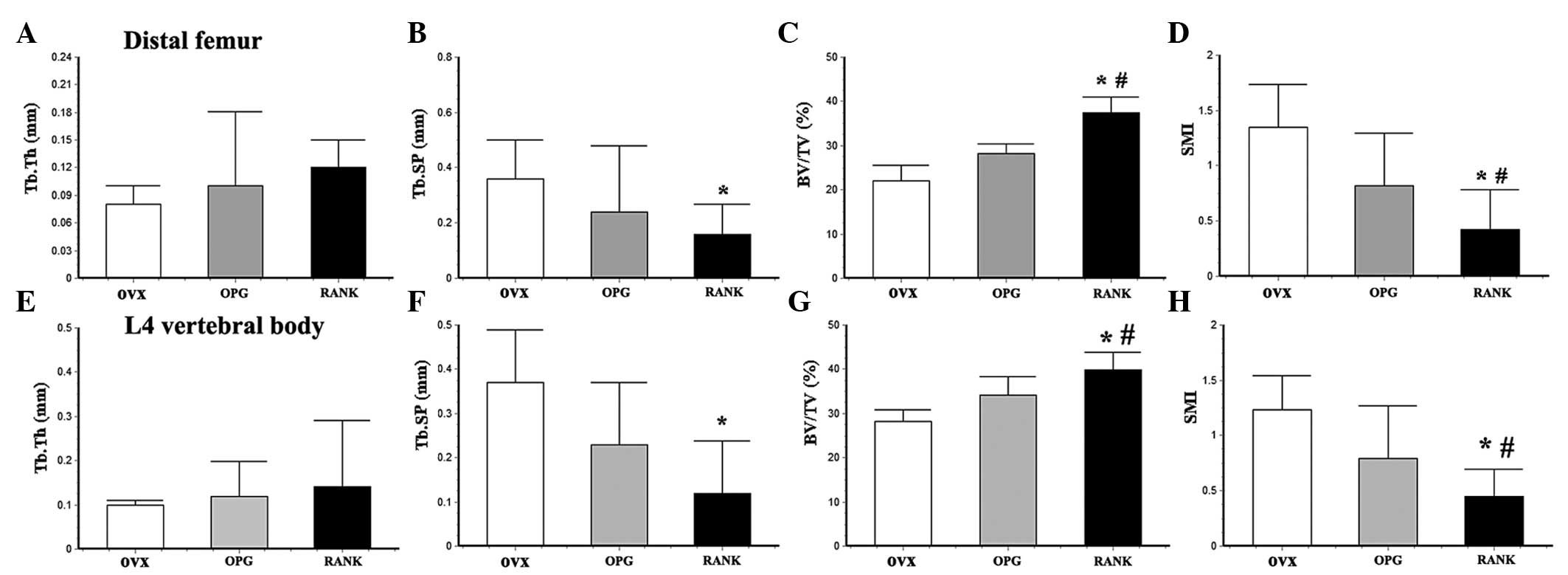|
1
|
Manolagas SC: Birth and death of bone
cells: Basic regulatory mechanisms and implications for the
pathogenesis and treatment of osteroporosis. Endocr Rev.
21:115–137. 2000.PubMed/NCBI
|
|
2
|
Takayanagi H: Osteoimmunology: shared
mechanisms and crosstalk between the immune and bone systems. Nat
Rev Immunol. 7:292–304. 2007. View
Article : Google Scholar : PubMed/NCBI
|
|
3
|
Deal C: Bone loss in rheumatoid arthritis:
systemic, periarticular, and focal. Curr Rheumatol Rep. 14:231–237.
2012. View Article : Google Scholar : PubMed/NCBI
|
|
4
|
Geusens P and Lems WF: Osteoimmunology and
osteoporosis. Arthritis Res Ther. 13:2422011. View Article : Google Scholar : PubMed/NCBI
|
|
5
|
Yasuda H: RANKL, a necessary chance for
clinical application to osteoporosis and cancer-related bone
diseases. World J Orthod. 4:207–217. 2013. View Article : Google Scholar
|
|
6
|
Kawai M, Mödder UI, Khosla S and Rosen CJ:
Emerging therapeutic opportunities for skeletal restoration. Nat
Rev Drug Discov. 10:141–156. 2011. View
Article : Google Scholar : PubMed/NCBI
|
|
7
|
Mizuno A, Amizuka N, Irie K, et al: Severe
osteoporosis in mice lacking osteoclastogenesis inhibitory
factor/osteoprotegerin. Biochem Biophys Res Commun. 247:610–615.
1998. View Article : Google Scholar : PubMed/NCBI
|
|
8
|
Khosla S: Minireview: the OPG/RANKL/RANK
system. Endocrinology. 142:5050–5055. 2001. View Article : Google Scholar : PubMed/NCBI
|
|
9
|
Weitzmann MN: The Role of Inflammatory
Cytokines, the RANKL/OPG Axis, and the Immunoskeletal Interface in
Physiological Bone Turnover and Osteoporosis. Scientifica-Cairo.
2013:1257052013.PubMed/NCBI
|
|
10
|
Lacey DL, Timms E, Tan HL, et al:
Osteoprotegerin ligand is a cytokine that regulates osteoclast
differentiation and activation. Cell. 93:165–176. 1998. View Article : Google Scholar : PubMed/NCBI
|
|
11
|
Kong YY, Yoshida H, Sarosi I, et al: OPGL
is a key regulator of osteoclastogenesis, lymphocyte development
and lymph-node organogenesis. Nature. 397:315–323. 1999. View Article : Google Scholar : PubMed/NCBI
|
|
12
|
Pettit AR, Ji H, von Stechow D, et al:
TRANCE/RANKL knockout mice are protected from bone erosion in a
serum transfer model of arthritis. Am J Pathol. 159:1689–1699.
2001. View Article : Google Scholar : PubMed/NCBI
|
|
13
|
Shiotani A, Takami M, Itoh K, Shibasaki Y
and Sasaki T: Regulation of osteoclast differentiation and function
by receptor activator of NFkB ligand and osteoprotegerin. Anat Rec.
268:137–146. 2002. View
Article : Google Scholar : PubMed/NCBI
|
|
14
|
Liu J, Xu K, Wen G, et al: Comparison of
the effects of genistein and zoledronic acid on the bone loss in
OPG-deficient mice. Bone. 42:950–959. 2008. View Article : Google Scholar : PubMed/NCBI
|
|
15
|
Wang Y, Huang P, Tang PF, Chan KM and Li
G: Alendronate (ALN) combined with osteoprotegerin (OPG)
significantly improves mechanical properties of long bone than the
single use of ALN or OPG in the ovariectomized rats. J Orthop Surg.
6:342011. View Article : Google Scholar
|
|
16
|
Zhang J, Dai J, Yao Z, Lu Y, Dougall W and
Keller ET: Soluble receptor activator of nuclear factor kappaB Fc
diminishes prostate cancer progression in bone. Cancer Res.
63:7883–7890. 2003.PubMed/NCBI
|
|
17
|
Oyajobi BO, Anderson DM, Traianedes K,
Williams PJ, Yoneda T and Mundy GR: Therapeutic efficacy of a
soluble receptor activator of nuclear factor kappaB-IgG Fc fusion
protein in suppressing bone resorption and hypercalcemia in a model
of humoral hypercalcemia of malignancy. Cancer Res. 61:2572–2578.
2001.PubMed/NCBI
|
|
18
|
Wang BL, Liang H, Zheng F, Li XX, Liu YB
and Dai CL: Recombinant soluble receptor activator of nuclear
factor-kappaB inhibits parathyroid hormone-induced
osteoclastogenesis in vitro. Sheng Li Xue Bao. 59:169–174.
2007.PubMed/NCBI
|
|
19
|
Tang P, Zhang L, Xu M, Zhang L and Wang Y:
Inhibition of the osteoclast activity with the application of
recombinant murine RANK protein. Artif Cells Blood Substit Immobil
Biotechnol. 38:169–177. 2010. View Article : Google Scholar : PubMed/NCBI
|
|
20
|
Hefley TJ and Stern PH: Isolation of
osteoclasts from fetal rat long bones. Calcif Tissue Int.
34:480–487. 1982. View Article : Google Scholar : PubMed/NCBI
|
|
21
|
Anderson DM, Maraskovsky E, Billingsley
WL, et al: A homologue of the TNF receptor and its ligand enhance
T-cell growth and dendritic-cell function. Nature. 390:175–179.
1997. View Article : Google Scholar : PubMed/NCBI
|
|
22
|
Vitovski S, Phillips JS, Sayers J and
Croucher PI: Investigating the interaction between osteoprotegerin
and receptor activator of NF-kappaB or tumor necrosis
factor-related apoptosis-inducing ligand: evidence for a pivotal
role for osteoprotegerin in regulating two distinct pathways. J
Biol Chem. 282:31601–31609. 2007. View Article : Google Scholar : PubMed/NCBI
|
|
23
|
Zhang S, Liu C, Huang P, et al: The
affinity of human RANK binding to its ligand RANKL. Arch Biochem
Biophys. 487:49–53. 2009. View Article : Google Scholar : PubMed/NCBI
|
|
24
|
French DL, Muir JM and Webber CE: The
ovariectomized, mature rat model of postmenopausal osteoporosis: an
assessment of the bone sparing effects of curcumin. Phytomedicine.
15:1069–1078. 2008. View Article : Google Scholar : PubMed/NCBI
|
|
25
|
Seibel MJ: Biochemical markers of bone
turnover: Part I: Biochemistry and variability. Clin Biochem Rev.
26:97–122. 2005.
|
|
26
|
Szulc P and Bouxsein ML: Overview of
osteoporosis: Epidemiology and clinical management. Veterbral
Fracture Initiative Resource Document PART I. 2011.
|
|
27
|
Kanis JA, Melton LJ III, Christiansen C,
Johnston CC and Khaltaev N: The diagnosis of osteoporosis. J Bone
Miner Res. 9:1137–1141. 1994. View Article : Google Scholar : PubMed/NCBI
|













